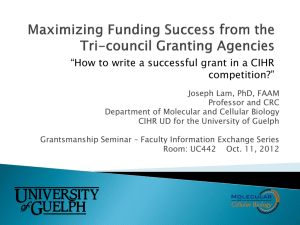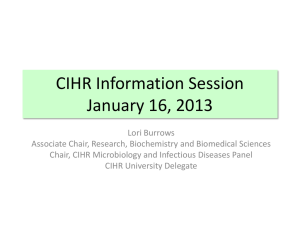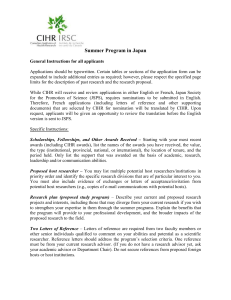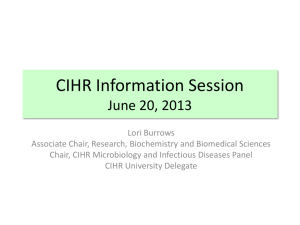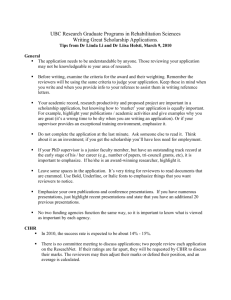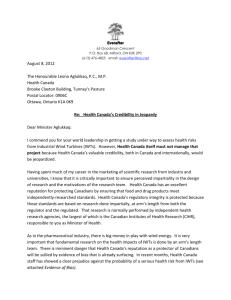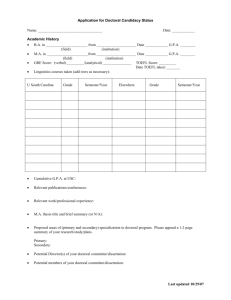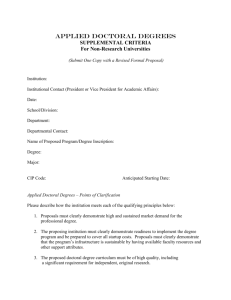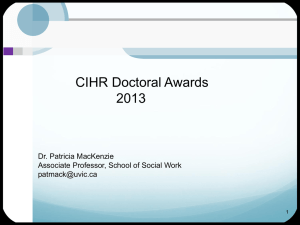here.
advertisement
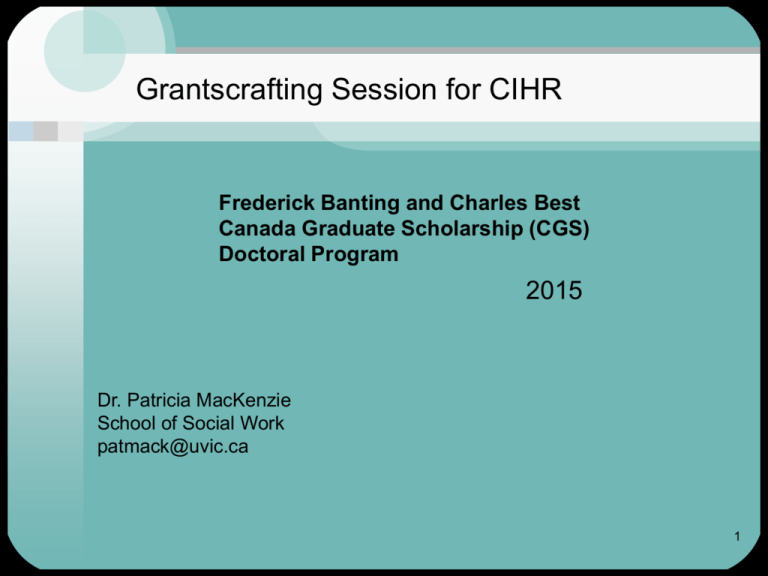
Grantscrafting Session for CIHR Frederick Banting and Charles Best Canada Graduate Scholarship (CGS) Doctoral Program 2015 Dr. Patricia MacKenzie School of Social Work patmack@uvic.ca 1 Today I will talk about… What is CIHR? CIHR Funding Opportunities Application Process Tips for Grants crafting Question/answer time What is CIHR? CIHR promotes a solutions-focused, multidisciplinary and collaborative approach to health research that is underpinned by high ethical standards. Its unique structure comprising 13 virtual Institutes brings together researchers and knowledge users from across disciplines, professions, sectors and geographic borders. CIHR currently supports the health research and knowledge translation activities of over 13,700 health researchers and trainees in universities, teaching hospitals and other health organizations and research centres across the country. Investment decisions are guided by a rigorous and transparent peer review process that selects for and meets the highest international standards of excellence. CIHR’s new strategic plan for 2014/15 – 2018/19 is called Health Research Roadmap II: Capturing Innovation to Produce Better Health and Health Care (Roadmap II) 3 CIHR Research Themes • • • • Biomedical Clinical Health systems services Social, cultural, environmental and population health 4 CIHR Institutes • • • • • • • • • • • • • CIHR Institute of Aboriginal Peoples’ Health CIHR Institute of Aging CIHR Institute of Cancer Research CIHR Institute of Circulatory and Respiratory Health CIHR Institute of Gender and Health CIHR Institute of Genetics CIHR Institute of Health Services and Policy Research CIHR Institute of Human Development, Child and Youth Health CIHR Institute of Infection and Immunity CIHR Institute of Musculoskeletal Health and Arthritis CIHR Institute of Neurosciences, Mental Health and Addiction CIHR Institute of Nutrition, Metabolism and Diabetes CIHR Institute of Population and Public Health 5 CIHR’s health and health system research priorities for 2014-15 to 2018-19 • • • • Research Priority A: Enhanced patient experiences and outcomes through health innovation This research priority focuses on accelerating the discovery, development, evaluation and integration of health innovations into practice so that patients receive the right treatments at the right time. Research Priority B: Health and wellness for Aboriginal peoples This research priority focuses on supporting the health and wellness goals of Aboriginal peoples through shared research leadership and the establishment of culturally sensitive policies and interventions. Research Priority C: A healthier future through preventive action This research priority focuses on a proactive approach to understanding and addressing the causes of ill health, and on supporting physical and mental wellness at the individual, population and system levels. Research Priority D: Improved quality of life for persons living with chronic conditions This research priority focuses on understanding multiple, co-existing chronic conditions, and on supporting integrated solutions that enable Canadians to continue to participate actively in society. 6 Examples of research areas and knowledge translation activities for Research Priority A: Enhanced patient experiences and outcomes through health innovation Health innovations • Discovery and development • New targets and technologies for improved diagnostics, therapeutics and therapies Improved practice guidelines • New technologies that support providers and patients • New models of financing, funding and delivering health care Evaluation • Patient experience and satisfaction research • Patient outcomes research • Health policy and systems research • Economic evaluation and technology assessment • Comparative effectiveness research • Clinical research Implementation and scale-up • Commercialization and uptake of predictive, preventive and precision clinical innovations • Integration of e-enabled health care models • Validation of health care financing, funding and delivery models 7 Examples of research areas and knowledge translation activities for Research Priority B: Health and wellness for Aboriginal peoples Aboriginal peoples’ health Shared leadership •Aboriginal people's research leadership capacity and development •Understanding of indigenous ways of knowing and knowledge translation Culturally sensitive policies and interventions •Factors influencing conditions of vulnerability and health equity •Design, implementation and evaluation of policies and interventions •Adoption and use of intervention programs, tools and services Sharing knowledge across jurisdictions and populations •International linkages and comparisons •Shared innovations 8 Examples of research areas and knowledge translation activities for Research Priority C: Promoting a healthier future through preventive action Health promotion and prevention Discovery and understanding • Environmental, social, economic and cultural determinants of health • Psychological and behavioural influences on health • Biological action and disease mechanisms • Interplay of biopsychosocial risk factors Health promotion • Healthy lifestyle strategies across the life course • Health literacy and education strategies • Policy and other interventions in health and other sectors • Healthy environments, food security and safety Disease prevention • Surveillance and screening for early detection and prevention • Novel vaccines and other therapeutics • Improved containment strategies for health threats (pathogens, contaminants, toxins) • System coordination across health and other sectors 9 Examples of research areas and knowledge translation activities for Research Priority D: Improved quality of life for persons living with chronic conditions Management and treatment of chronic conditions Discovery and understanding • Comorbidities, common disease pathways and interactions • Factors influencing chronicity • Complexities of diagnosis, treatment and care across the life course • Promoters and barriers to self-management Primary and acute health care • Integrated health care delivery models, including team-based models of care • Innovative policies, strategies and programs • Rehabilitation therapies and medical devices Long-term management • Self-care and self-management strategies • Community-based care models • Support for caregivers and family • Workplace accommodation • Organizing and financing of institutional care 10 What are the Funding Opportunities ? The CIHR Doctoral Research Awards consist of two programs administered through a single application: 1.The Frederick Banting and Charles Best Canada Graduate Scholarships Doctoral Awards (CGS-D) program provides special recognition and support to students who are pursuing a doctoral degree in a health-related field in Canada. 1.Some Canada Graduate Scholarship recipients may be considered for the honour of having their scholarship named a “Canada Graduate Scholarship to Honour Nelson Mandela”, should CIHR deem their application to be aligned with at least one of five themes championed by Mandela: national unity; democracy; freedom and human rights; leadership; children’s participation in society; and children’s health. 1.The Doctoral Foreign Study Award (DFSA) provides special recognition and support to students who are pursuing a doctoral degree in a health-related field abroad. Applicants apply to the CIHR Doctoral Research Awards competition and top-ranked applicants are awarded a CGS-D or DFSA depending on the proposed location where the doctoral degree will be pursued and granted. Note: Changes from proposed location from Canada to abroad or the opposite will not be considered by CIHR. All applicants are expected to have an exceptionally high potential for future research achievement and productivity. 11 THE CIHR DOCTORAL FUNDING APPLICATION DEADLINE IS OCTOBER 1, 2015. • • You will apply online and submit your electronic application directly to CIHR for an opportunity to be funded with a Doctoral Research Award (DRA) There is no university pre-selection process • CIHR HAS JUST RECENTLY PROVIDED US WITH UPDATED INSTRUCTIONS REGARDING THE SIGNATURE PAGES: • Candidates must: • print the signature pages and get their supervisor(s) signatures only • scan the duly completed signature pages and upload them to their application (NI candidates must scan and upload the blank signature pages); • submit electronically their completed application to the ” institution paid” that they indicated in their application. Once you have completed your application, the UVic Scholarship Officers now e-approve your application in ResearchNet in lieu of the of institutional signatures, before it goes to CIHR. 12 How much and How many? For this competition, applications will be accepted in all areas of health research, including biomedical, clinical, health services and social, cultural, environmental and population health. • It is anticipated that approximately $14 million over three years will be available for the CGS-D competition, enough to fund approximately 133 awards. • It is anticipated that approximately $1.05 million over three years will be available for the DFSA competition, enough to fund approximately 10 awards. Trainee stipend: $30,000 per annum plus a Research allowance: $5,000 per annum. 13 ….also available… CIHR Priority Announcement 2015 ….offer additional sources of funding for highly rated applications that are relevant to specific CIHR research priority areas or mandates. Applications are submitted through the "201510MDR" competition of the Doctoral Research Award: 2015-2016 funding opportunity. CIHR Research Priority Areas •Aboriginal Research Methodologies •Infection and Immunity •Research in First Nations, Métis and/or Inuit Health The total amount available for these funding opportunity is enough to fund three (3) awards for each priority area. This amount may increase if additional funding partners or internal collaborators decide to participate. 14 Eligibility • • • • • • • • • • The Nominated Principal Applicant must be a trainee. A primary supervisor must be identified on the application. An additional supervisor may be identified. The program is open to Canadian citizens and permanent residents of Canada at the time of application. Only students engaged in a full-time doctoral program that has a significant research component are eligible to apply. An eligible program of study must require that 75% of the students' time be devoted to research training. The research component must be a requirement for completion of the program, such as the completion of a thesis, a major research project, a dissertation, a scholarly publication, a presentation and/or an exhibit that is merit/expert reviewed at the institutional level. Doctoral programs that are based only on course work are not eligible. Joint doctoral programs with a professional degree (e.g. MD/PhD, MBA/PhD, DVM/PhD, etc.) and clinically-oriented doctoral programs (e.g. PhD in Clinical Psychology) are eligible if they have a significant research component as described above. For the purposes of eligibility assessment, the health professional degree portion of the combined degree program will not be counted as graduate study. The maximum duration of award funding from all federal sources to undertake graduate studies is four years, including at the Master's level. Individuals who hold or have held a doctoral award from a federal source for a term of three years are not eligible to apply. Applicants may submit only one training or salary award application per year (September 1 to August 31) for funding from the Natural Sciences and Engineering Research Council of Canada (NSERC), the Canadian Institutes of Health Research (CIHR) or the Social Sciences and Humanities Research Council of Canada (SSHRC). However, individuals eligible to apply to the Vanier Canada Graduate Scholarships program or the Banting Postdoctoral Fellowships program may also submit an application to the CIHR Doctoral Research Award program (this is the only exception where an individual may submit two applications in the same year). As of the application deadline, all candidates must have completed a minimum of 12 months of graduate study at the Master's or doctoral level. In addition, there are also maximum amounts of time* a candidate can be registered as a full-time student in a doctoral program (as of the application deadline), in order to be eligible to apply. *…range from 22 to 34 months 15 The Application Process http://www.cihrirsc.gc.ca/e/38887.html#A So, before you begin Applicants and their supervisor(s) must make sure they have the following (if not, click on the following links to register): • a ResearchNet account • a CIHR PIN in ResearchNet • a Common CV account Applicants and their supervisor(s) should each only have one ResearchNet account. If you have already accessed ResearchNet, do not register for a new account. 17 Summary: tasks required for completing a Doctoral Research Award application 1. Complete the Common CV 2. Complete the Doctoral Research Award ResearchNet application a) Identify Participants b )Identify Sponsors (3) c) Enter Degree Information d) Enter Proposal Information e) Enter Space, Facilities and Personnel Support Information f) Attach Other Application Materials Apply to Priority Announcements / Funding Pools (Optional) g) Print/Upload Signature Pages h) Preview i) Consent and Submit 18 Summary of the Application Process • Award programs use an automated application process through the use of ResearchNet (with a few exceptions). • Review the ‘How to Apply’ section and the Application Phase Instructions (if applicable) of the Funding Opportunity to which you are applying. • Review the “Guide for Reviewers” section of the Funding Opportunity for tips on how to strengthen your application. • Review the “Grants and Awards” Guide for policies related to the administration of applications. Pay attention to the details follow instructions exactly adhere to format guidelines (e.g., font, page limits) applications MUST be completed using the media specified in the funding opportunity use the full page allowances familiarize yourself with the Guide for Reviewers start several weeks before the deadline – right now! Preview - Criteria Used by Reviewers for Doctoral Awards Criterion Weights for each criterion Achievements and Activities of the Candidate Publication Activity 10 % Other Research Activity 10 % 35 % Academic Performance 15 % Characteristics and Abilities of the Candidate Critical thinking Independence Perseverance Originality 40 % 40 % Organizational skills Interest in discovery Research Ability Leadership The Research Training Environment Training program for the 10 % candidate Scientific Activity 5% 25 % Research resources 5% Training record 5% 100% 100% 21 22 Working with your grantscrafter • Seek advice early • Role is provide positive criticism • Not a guarantee that you will receive the award 23 Planning for Success Grades matter! Reference/Sponsor Letters are very, very important – choose wisely Emphasize publications, research experience, professional experience A strong training environment where you will get exposure to research and have research networking and mentoring opportunities is essential Context and Support Matters! work on the research proposal and the full application in collaboration with your supervisor/mentor proofread your application … carefully! show the complete application to their supervisor/mentor, peers and other researchers for feedback Be prepared to produce multiple drafts If you can, set up an internal review system – other students who have been successful, other applicants, profs, etc. Even if not successful you will produce a draft of your thesis proposal so think positive Do not wait to submit until the last minute CIHR Sponsor’s Assessments • • Candidates should choose sponsors that know them well enough to be able to assess their potential and to provide specific examples of their behaviour with respect to each characteristic on the sponsor assessment form. You should help your sponsor prepare their letter by providing examples that match the evaluation criteria (excellence, productivity, etc.) An automatic e-mail will be sent through ResearchNet to the chosen sponsors. After all three sponsors have submitted their assessments, this task will be marked as Complete in the ResearchNet Application Task List. Sponsors must submit their assessments by the deadline date. You need to make sure this happens! The “Narrative” • A well-laid out proposal says to a committee “this person knows what they are talking about and they have taken as much care with their proposal as we are now doing.” • Reviewers are busy people and have many proposals to read. Make yours one they will want to read! • Ensure you convey what you are proposing is relevant, unique, and will benefit the health of Canadians 27 Think about the ‘audience’ • Assessors may have the kind of specialized knowledge you need, but a committee will not. • Provide a rapid introduction for intelligent non-specialists. • Provide appropriate (and recent!) references. 28 Provide Information Clearly • Committees are not only not infallible and tired, they are also starting with imperfect information about you and your institution. • Give them the information you know is essential to your case, straightforwardly and succinctly. 29 Logical and Connected Proposal • Present research plans coherently, as a set of problems. • In a logical and connected order. • Always state the central problem of your work and why it is important. 30 Critiques • If you are critiquing existing models or approaches in the literature, • do so lucidly, without partisanship, and • demonstrate clearly why your approach is better. • Be precise. 31 Who is the Audience? Adjudication Committees • Most of these committees are interdisciplinary; some are not; some have non-academics on them. They are your audience – write to them. • Committees get tired and impatient with complex obscure language, typos, poorly laid-out proposals with grammar and spelling errors, and incomplete information. 32 Peer Review Committees and Mandates – Doctoral Research Award The applications are assigned to a specific committee based on the theme of the proposed research activities. •The evaluation of Doctoral Research Award applications focuses on the applicant's track record, characteristics and abilities as well as the research proposal and environment/support. •Doctoral Research Award – A (DRA) •Reviews Doctoral Research Award applications to assess the candidate’s potential of attaining competence as a prospective researcher in biomedical and/or clinical research. •Doctoral Research Award – B (DRB) •Reviews Doctoral Research Award application’s to assess the candidate’s potential of attaining competence as a prospective researcher health services research and/or social, cultural, environmental and population health research. 33 Editing • Ask a friend who is not overly familiar with your research to read your proposal some day/evening when he/she is tired and see if it makes sense. • Then ask your friend to tell you which bits are confusing, or that had to be read twice. • Then sit down again and work on getting rid of the jargon, or the long sentences, or . . . 34 Additional Information: Facilitated Online Sessions - Webinars CIHR holds several short, web-based, facilitated online sessions (also called "webinars"), which include seminars, presentations, lectures, workshops and conferences that are transmitted over the web. They are free but you must register. Next dates are Sept 8th and 10th at 11AM ET. 35 Final Observations • Grant competitions are still going to be, on occasion, unfair. • After one rejection, do not despair. . . or at least, not for long. • There will be comments that come with the decision. • Take the advice that makes sense to you; ponder the rest, and then accept or reject it. 36 Thank You Questions? 37 Contact Info Dr. Patricia MacKenzie patmack@uvic.ca 38
